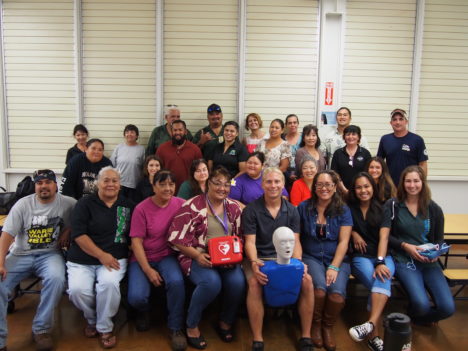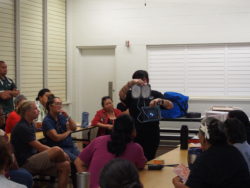MHS Gifted Life-Saving Device

Photo by Catherine Cluett Pactol
By Catherine Cluett Pactol
Molokai High School may have an extra chance to save lives in an emergency thanks to an automated external defibrillator (AED) that was recently donated to the school by Hawaii Life Flight. An AED is an electronic device that can diagnose certain heartbeat irregularities causing cardiac arrest and administer electric shock to reestablish proper heartbeat rhythm. MHS’ new device will be located in the school’s cafeteria, and will join two other AEDs on campus — one in the gym and one in the health room.
“This is a function that anyone can do once you’re trained in it, and in conjunction with CPR, the survival rate is high,” said Lori Cannon, a nurse of over 30 years who now works for Hawaii Life Flight as a flight nurse.
The air ambulance company operates around the state and in 2014, established a Molokai-based crew and plane that serves the island.
Cannon said when someone collapses in front of you, it’s both nerve-wracking and emotional. Thanks to the AED’s simple audio and visual instructions, the machine can help guide average citizens to perform a potentially life-saving procedure.

Photo by Catherine Cluett Pactol
“That’s the importance of the AED, you don’t really need medical personnel there… everybody in this room can save a life,” Cannon told a group of teachers, staff and students gathered last week at the school for a short course on AED use. “Anybody can collapse at any time, anywhere.”
Those who received education on the AED included department heads, athletic personnel, cafeteria staff and student members of the school club Health Occupation Students of America, who are interested in pursuing careers in health fields.
Cannon explained that there are two heart rhythms that can be treated with the AED, ventricular fibrillation and ventricular tachycardia. One you turn on the device and place the pads on the patient as it instructs, the machine will diagnose whether or not the patient suffers from either of those rhythms. It will then instruct the user to administer the electric charge or not. Before initiating use of the AED, call 9-1-1 and follow the instructions given by the device, in combination with CPR.
“There’s a lot of strength and passion when you’re trying to resuscitate somebody and give them that chance at life again,” said Cannon.
The Good Samaritan law in Hawaii prevents someone from being sued who’s trying to help with good intentions, Cannon said.
MHS Vice Principal Kainoa Pali said one of his responsibilities is keeping the campus safe and the AED is one example.
“These things cost money so to have a chance to work with [Hawaii Life Flight] is a privilege,” he said. “The more people that know how to use this, the more lives we can save.”











Don't have a Molokai Dispatch ID?
Sign up is easy. Sign up now
You must login to post a comment.
Lost Password